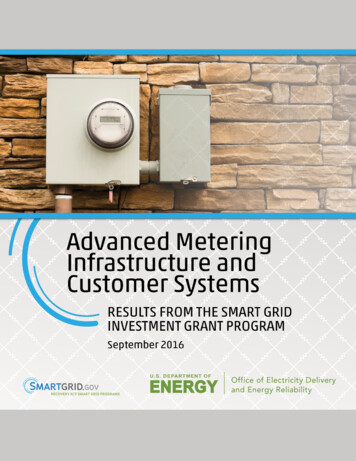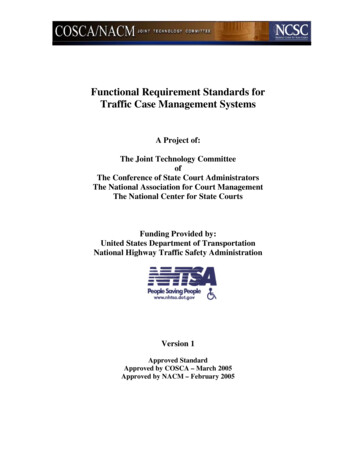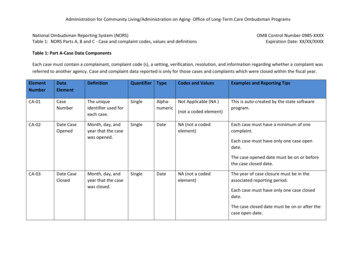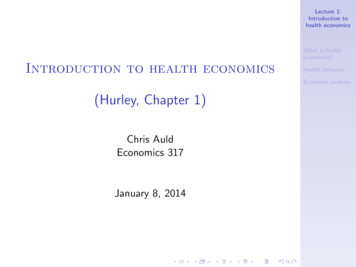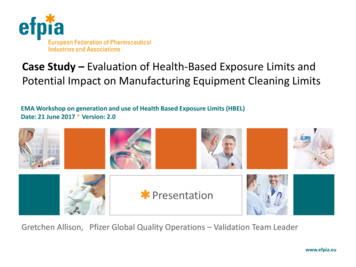
Transcription
Case Study – Evaluation of Health-Based Exposure Limits andPotential Impact on Manufacturing Equipment Cleaning LimitsEMA Workshop on generation and use of Health Based Exposure Limits (HBEL)Date: 21 June 2017 * Version: 2.0PresentationGretchen Allison, Pfizer Global Quality Operations – Validation Team Leaderwww.efpia.eu
Outline Background/Scope Step By Step Example Industry Experience Considerations for Inspections/KeyMessageswww.efpia.eu2
ScopePrimary Scope of this Case Study: Drug Product Commercial Drug ProductSmall MoleculeNew vs LegacyProduct residue removal (vs micro, cleaning agent removal)Non-dedicated Manufacturing Equipmentwww.efpia.eu3
Background Historically used drug product manufacturing equipment cleaninglimits based on 1/1000 minimum therapeutic dose Some markets still expect 1/1000 dose limit, or lower of that andNMT 10 ppm limit Any cleaning must pass visual inspection EMA Health Based Exposure Limit (HBEL) guide published, effective2015 Some other markets (e.g. PICS, China) also expect HBEL assessmentin establishing cleaning limits New active ingredients and associated drug product havedocumented HBEL at the time of commercialization ADE PDE For older (legacy) products already on the market, it’s a bit morecomplicated .www.efpia.eu4
For existing/older (legacy) products already on the market, it’s a bitmore complicated .63ManufacturingSites 74Billion Dosesin one year 30,000Colleagues850 25,000 ProductsSKUs 450130ContractManufacturers 5,000SuppliersLogisticCentersPatients in129 30 LegacyCompaniesCountries5
Overview of WorkprocessFor Legacy Products: Assess ADE based cleaning limitsStep 1: Identify and prioritize existing Active Ingredients andassociated Drug Products for HBEL evaluationStep 2: Establish ADE value: see scenarios on next slideStep 3: Compare health based cleaning limit to existing cleaning limit Where existing cleaning limit (e.g. based on 1/1000 minimum therapeuticdose) is lower than health-based (ADE) derived cleaning limit, the existingcleaning limit maybe retained as an acceptable approachWhere health based derived cleaning limit is lower than existing cleaninglimit, a new health based cleaning limit is implemented for use. This mayrequire: Cleaning, sampling, and analytical test method detection levelevaluation Potentially lower detection limits to be established and validatedMust be done on product by product basis. For sites with many legacyproducts significant time/resourceReference flowchart slide for workprocesswww.efpia.eu6
Step 2 Scenarios: Establishing ADE valueScenario A: For new active ingredients/drug product documented HBELin place at the time of commercialization i.e. ADE values availableScenario B: If no ADE available: Screen out highly sensitizing beta lactams and review Segregationproduct assessment For all Other products with no ADE value: Check OEL/OEB monograph:is it based on clinical data? If the OEL/OEB is based on the low clinical dose, then ADEdevelopment can be assigned a lower priority as 1/1000 the sameminimum therapeutic dose (MTD) will be sufficiently conservative– regardless of how high or low (i.e., “potent”) the MTD may be. If the OEL or OEB is NOT based on the low clinical dose then theproduct is prioritized for Tox review and estimation of the ADEusing the OEL/OEB monograph. Compare against currentcleaning limit and prioritize full ADE development, as needed For lower priorities, ADE to be developed per prioritized plan Once ADE developed, calculate cleaning limit based on ADE andcompare to existing cleaning limitwww.efpia.eu7
Flow chart (derived from PharmTech Europe Dec2015 publication)www.efpia.eu8
Example of small molecule cleaning limits calculationusing the ADE value and minimum therapeutic doseCommon Industry Cleaning Limit Calculations:Step 1: Calculate Maximum Allowable Residue (MAR) as mg of ProductA per kg of Product B for either: A specific product changeover of Product A to Product B, or Calculate a worst case cleaning limit considering all products made in sameequipmentMinimum Therapeutic Dose MAR : For 1/1000 min. therapeutic dose, SF 0.001Dose MAR TA (mg of A) · conversion (106 mg of B/kg of B) · (SF)BB (units of product B) · CB (mg of B/unit)Health Based Exposure Limit (Tox) MARADE/PDETOX MARADE/PDE ADE or PDE (mg of A/day) conversion (106mg of B/kg of B)BB (units) CB (mg of B/unit)www.efpia.eu9
Example of cleaning limits calculation using the ADE valueand minimum therapeutic doseCommon Industry Cleaning Limit Calculations (Continued):Step 2: Using Calculated MAR from Step 1, convert MAR to the allowedamount per cleaning sample:Residue Acceptance Limit (RAL) for Swabs as (mcg of A) per Swab:Swab RAL MAR (mg of A/kg of B) · LB (kg of B) · AS (cm2/swab) · conversion (103 mcg A)/(mg A)EW (Equipment Surface Area in cm2)RAL for Rinsate as (mg of A) per kg of Rinse:Rinsate RAL MAR (mg of A)/(kg of B) · LB (kg of B)WR (kg of Rinse Used)www.efpia.eu10
Example 1: Resulting Swab Cleaning Limit GridProduct A Drug Product being cleaned out of equipmentProduct B Next Drug Product to be made in that equipmentFor a given manufacturing equipment producing 4 different DrugProducts, one would have the following permutations of cleaninglimits for each change-over cleaning:Changeover from Product 1 to product 3 results in the worst caselowest cleaning limitwww.efpia.eu11
Example 2: Establishing Worst Case CleaningLimits for Therapeutic CompoundsProduct12345InputTA2.551050100Worst case Prod 1 iscomment 0800HighestweightResultMax DailyDosage (mgdosageunit/day)1505001,3201,2503,200Nextproduct 5 EW(cm2)(mg A/Kgnext drugProduct1to 3)65010002007507001.89-----Prod 3 issmallestbatchProd 1to 3 islowest100100100100100100,000100,000Note when establishing worst case limits, the worst case Product A toProduct B changeover scenario is typically used in the calculation.www.efpia.euResulting in overly conservative limit for most changeover scenarios.12
Example 3: Spreadsheet Reflecting the Inputs forProvisional ADE ValuesAfter screening of products for potential segregation, assessOther products made in that ADE Value(Oral)(mg/day)ADE Value(Parenteral)(mg/day)Product 1Product 2Product 3Product 4Product 5MTDMTDMTDMTDLongterm 180230.030.70.08120.020.30.08Product 6MTD0.51300.020.02PK/MF Pharmacokinetic Adjustment Factor or Modifying FactorUFc Composite Uncertainty FactorMTD Minimum Therapeutic Dose“Other” Segregation not required per Segregation Quality Standardwww.efpia.eu13
Step by Step ExamplePrioritizing Development of Health-Based Exposure Values andEvaluating Effectiveness of Current Cleaning LimitsFollow the decision tree tool in Flowchart1. Identify the product: ‘Capzone’2. Check if the ADE value for Capzone is available.www.efpia.eu14
Step 3: If an ADE value is available If an ADE value is available, perform the cleaning limit (CL)calculation. Or, compare the ADE value directly to the 1/1000minimum therapeutic dose value used in the cleaning limitcalculation, since the rest of the variables of the cleaning calculationare identical whether performing a dose based limit or an ADE basedlimit calculation. Compare if the CL using ADE is greater than, or less than the currentlimit. Document the assessment and conclusions, including effect onthe Cleaning Validation (CV) Program:— If the new health-based CL or equal to Current CL, canmaintain current CL.— If the new health-based CL is current CL, evaluate thedifference between the two CLs with site Quality Assurance,Production, EHS, Quality Control (if applicable) for furtherdiscussion and resolution.www.efpia.eu15
Step 3: If an ADE value is not available forCapzone Determine if Capzone has been assessed for segregation (e.g.highly sensitizing beta lactam). If it does not require segregation: Verify if the OEL or OEB monograph is available Verify if the monograph is based on the minimum therapeuticdose:— Refer to the abstract on the first page of the monograph i.e. themonograph is based on the minimum therapeutic dose whenthe monograph states that it is based on clinical data, or bothclinical and nonclinical data— If it is not clear in the monograph that this was based on theminimum therapeutic dose then further toxicologist analysis isrequired (step 6) Verify if current cleaning limit (CL) was calculated using 1/1000thof the same minimum therapeutic dose used to calculate the OELor OEB. If so, then current CL is considered appropriate. Document theassessment and conclusions.www.efpia.eu16
Further toxicological analysis Further toxicological analysis is required when:— An ADE is not available and the product requires segregation assessment— The OEL or OEB is not based on the minimum therapeutic dose or is notavailable— If current CL was not calculated using 1/1000 of the same minimumtherapeutic dose used to calculate the OEL/OEB (e.g., it was calculatedusing NMT 10ppm, or used a SF of 1/100, etc.) The toxicologist determines if a provisional ADE value can be defined. If so, thesite may utilize it in the comparison to existing cleaning limits. The site will calculate a health based CL If the new health-based CL is lower than current CL, notify the toxicologist toprioritize the development of ADE value for re-analysis. Communicate to siteQuality Assurance, Production, EHS, Quality Control (if applicable) the potentialfor change to the current CL for further discussion and resolution.www.efpia.eu17
Finalize the assessment Once the ADE has been determined and approved, thesite will verify that the provisional and approved ADEvalues are the same. If not the same perform step 4 –recalculate the health based CL and compare to existingCL. If an ADE value cannot be determined (e.g. highlysensitizer Beta lactam products) then the site will reviewthe manufacturing segregation assessmentNote Steps need to be repeated for each productwww.efpia.eu18
Large Molecule Considerations Biological products often degrade anddenature during cleaning, rendering theminactive EMA HBEL guide Sect 5.3: using ADE value ofthe active and intact product may not berequired for macromoleculeswww.efpia.eu19
Industry ExperienceAt Pfizer: based on internal survey Assessment outcomes vary by manufacturing site: e.g. dependanton their equipment use (e.g. dedicated or multi-product), type ofproducts (e.g. small or large molecules) Generally in 85% of cases, dose cleaning limit is lower than healthbased cleaning limit using ADE, often by an order of magnitude ormore Performing the assessment for legacy products consumes significantresources (e.g. time)In industry: based on prior EfPIA survey: Generally in 85% of cases,dose cleaning limit is lower than health based cleaning limit using ADEwww.efpia.eu20
Industry ExperienceAt Pfizer: Why are sites reluctant to use/change to less stringenthealth based cleaning limits? Most sites have cleaning validation complete (or ongoing fornew products, other changes) Changing the cleaning limits requires re-assessment of:— The analytical test and sampling methods used to detect the productresidue (e.g. have they been validated in a range to include the newhigher limit?)— The equipment cleaning validated status: does validation need to bere-executed? There is risk of failing visual inspection after cleaning when usinghealth based cleaning limits, which are often significantly higherthan dose based cleaning limits If site experience is that they can consistently clean to the lowerdose limits, there is often little motivation to consume resourcesto assess using less conservative cleaning limits Some markets still expect dose based cleaning limitswww.efpia.eu21
Considerations for Inspections Developing HBELs for legacy products is time consuming, especially forsites with hundreds of products For legacy processes, assessing current cleaning limits vs HBEL derivedcleaning limits can take significant time and effort, depending on thenumber of products at a manufacturing site In majority of cases ( 85%), dose based cleaning limits used historicallyin industry are more conservative than use of HBEL cleaning limits Risked based approach to prioritization and assessment is wise use ofresources Do manufacturing sites have a documented risked basedplan/approach, especially for legacy products, with establishedtimelines? Are qualified toxicologists intimately involved with the process per thatdocumented plan/approach?www.efpia.eu22
Concluding remarks from the Associations All express their thanks for the opportunity toengage in dialogue at this workshop, and offertheir resources for future discussion For us, a successful outcome will ensure: The difference between risk and hazard is wellunderstood— Regulators will have confidence in the processes usedby industry to derive HBELs It’s not just about the numbers There is a lot of scholarship associated with derivingHBELs— It is understood that many, especially smaller,companies may not have site-based or in-houseexpertise and resources and may have to outsourcethe work— Extensive discussion about the derivation of HBELsduring an inspection may not be possiblewww.efpia.eu23
Next Steps We recommend a substantial revision of the Q&A document— Or revision to the SWP guidelineo We would appreciate an opportunity to comment on any future Q&A,reflection paper or revised guideline prior to release There are also topics of importance that remain to be resolved e.g.,— Relating to animal health products— Responsibilities of the manufacturer vs MAH Given the complexity of the subject matter, future timelines should becarefully considered— It may be that the recent implementation timelines were too short andresulted in some companies being unable to make sufficient investmentin HBEL determinations Similar to the increased collaboration between assessors and inspectors, wesupport the greater involvement of safety experts with the inspectorswww.efpia.eu24
Questions?www.efpia.eu
Backupwww.efpia.eu
Approach 2: How can I use the existing OEB to estimate a defaultADE band for comparison against the current cleaning limit forinvestigational product? OEB paradigm closely aligns with ADE value methodologyso bottom of band can be read to a default ADE value Same value as derived using Threshold of ToxicologicalConcern (TTC) outlined by Dolan et al 2005 Where existing cleaning limit is lower than the calculatedHBEL cleaning limit, development of a full ADE maybelower priorityPfizer OEBDefault ADE Value(default TTC per Dolan et al)OEB 110,000 ug/dayOEB 21,000 ug/dayOEB 3100 ug/dayOEB 410 ug/dayOEB 51 ug/daywww.efpia.eu27
www.efpia.eu 4 Historically used drug product manufacturing equipment cleaning limits based on 1/1000 minimum therapeutic dose Some markets still expect 1/1000 dose limit, or lower of that and NMT 10 ppm limit Any cleaning must pass visual inspection EMA Health Based Exposure Limit (HBEL) guide published, effective 2015 Some other markets (e.g. PICS, China) also expect HBEL .





